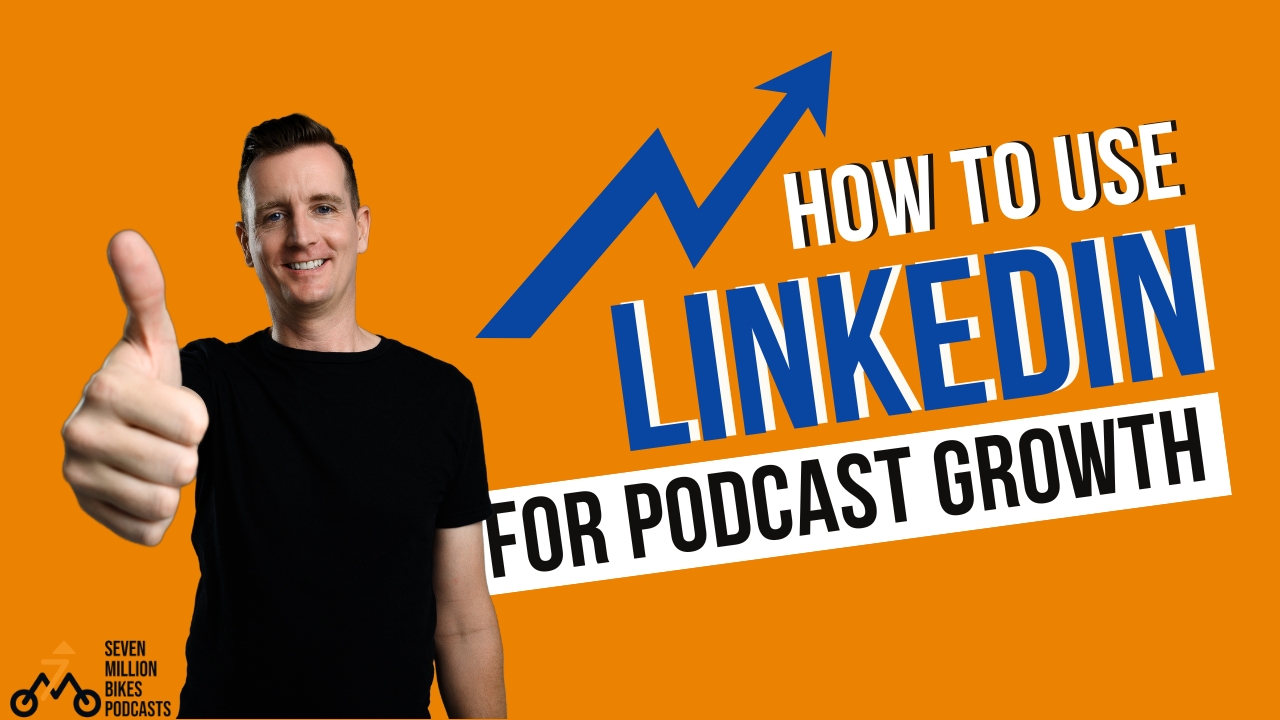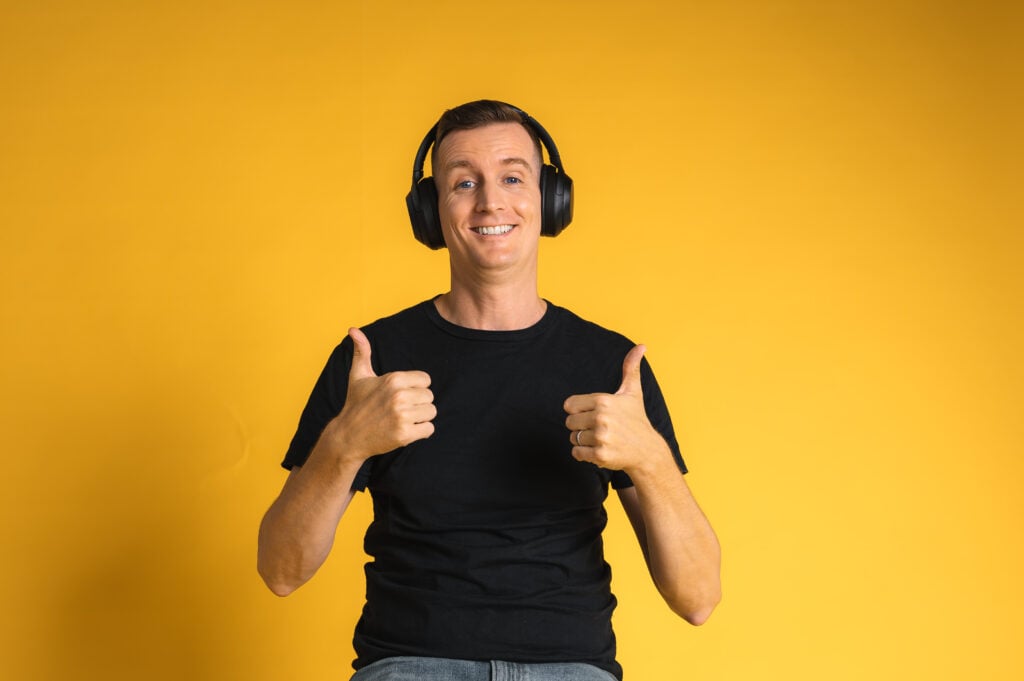My name is Niall Mackay, founder of Seven Million Bikes Podcasts.
As a podcaster, I’ve made mistakes, learned lessons, and figured out what works—and what doesn’t—when it comes to podcasting. I never really paid much attention to LinkedIn before, assuming it wasn’t relevant for podcast growth. But after making a serious effort to build my presence there, I’ve seen it make a huge difference.
That’s why I invited Joel Zorrilla, who has personally helped me improve my LinkedIn strategy. In this blog, we’ll talk about why LinkedIn is such a powerful tool for podcasters, how to use LinkedIn for podcast: optimize your profile for visibility, and the best strategies to grow your audience using LinkedIn.
Why LinkedIn is the Best Platform for Growing Your Podcast
My guest today is a creative B2B marketing and branding strategist who has worked with three startup companies, including preparing to launch his own. He also ran a successful food blog, which he later sold, and has helped businesses generate over $10 million in revenue.
I first met Joel when I attended one of his LinkedIn workshops, and it completely transformed the way I approach the platform. What I learned in that workshop instantly improved my LinkedIn presence, and I knew I had to bring him onto the podcast to share his insights with all of you.
When I first started promoting my podcast, I focused on Facebook and Instagram—they were the platforms I was most familiar with. But over time, I realized that growing a podcast through these channels was an uphill battle. Engagement was inconsistent, organic reach was declining, and paid ads weren’t delivering meaningful results.
Then, I discovered LinkedIn. And everything changed.
Unlike Facebook and Instagram, which cater to personal content, viral trends, and entertainment, LinkedIn is a business-focused platform. As Joel explained in our conversation, it’s essentially the playground for B2B professionals—a space where people are actively discussing industry trends, networking, and sharing insights to grow their businesses.
For podcasters, this makes a huge difference:
- On Facebook, your posts mainly reach friends and family, many of whom aren’t your target audience. The algorithm favors personal connections over business content, and unless you’re spending money on ads, your reach is severely limited.
- On Instagram, engagement relies heavily on visual appeal and manual networking—commenting on posts, DMing potential followers, and hoping they check out your profile. This can work, but it’s time-consuming and unpredictable.
- On LinkedIn, your audience is already interested in business-related content. If you create valuable posts and engage with the right people, LinkedIn’s algorithm rewards you by boosting your content to a wider audience.
That’s why every business-focused podcast should be on LinkedIn. Whether you’re interviewing industry leaders, discussing business strategies, or building a personal brand, LinkedIn puts your content in front of the right audience—people who are actually interested in what you have to say.
Why You Need to Be on LinkedIn, Even If You Love Facebook
For many podcasters, LinkedIn feels intimidating or unnecessary. If you’ve been using Facebook and Instagram for years, making the switch to LinkedIn can feel like starting over.
But here’s the truth: LinkedIn gives you access to an entirely different audience. Unlike Facebook, where your content is mostly seen by friends and family, LinkedIn connects you with people in your industry, potential clients, and collaborators.
Joel also pointed out that on Facebook, sending a friend request to a stranger can feel creepy—but on LinkedIn, connecting with new people is completely normal. That’s what the platform is designed for.
After our conversation, I made a conscious effort to grow my LinkedIn network. I started sending connection requests to B2B professionals, business owners, and podcasters. I included a simple message explaining why I wanted to connect, and most people accepted.
Over time, my LinkedIn following grew to thousands of relevant connections—many of whom would have never discovered me on Facebook or Instagram.
How to Promote Your Podcast With LinkedIn
Once I understood the value of LinkedIn, I wanted to make the most of it. Joel shared several key strategies that helped me grow my podcast and personal brand on the platform. By implementing these tactics, I’ve seen an increase in engagement, visibility, and overall reach.
Leverage Your Guests’ Networks
One of the most effective ways to grow a podcast is by tapping into the network of your guests. When you invite someone onto your show, they receive free PR, and most of them want to share that exposure with their audience.
Encouraging guests to share the episode on their LinkedIn can significantly expand your reach. Tagging them in your post makes it easy for them to reshare, ensuring the content gets in front of their followers. Another great strategy is asking them to include a link to your podcast in their posts. This simple action introduces you to their network, increasing your visibility.

Use SEO and Backlinking to Improve Podcast Visibility
Before speaking with Joel, I didn’t fully grasp how much SEO could impact podcast growth. However, after testing a few strategies, I saw firsthand how Google rankings could bring in new listeners.
Recently, I had a guest from Switzerland message me, asking if I could update the podcast thumbnail because when she Googled her name, my podcast appeared at the top. That simple moment reinforced the power of SEO and how podcasts can contribute to building a strong personal brand.
One of the best ways to optimize for search engines is by repurposing podcast content. Transcribing an episode using AI tools and turning it into a blog post for your website helps improve searchability.
Another effective approach is posting a rewritten version of the blog as a LinkedIn article. Google does not rank duplicate content, so it’s important to reword the post to ensure it remains unique. This helps with discoverability while also providing additional exposure for your podcast.
Optimize LinkedIn’s Algorithm by Posting Engaging Content
LinkedIn’s algorithm is designed to boost content that generates engagement within the first 30 minutes of posting. If a post receives likes, comments, and shares quickly, LinkedIn pushes it to a larger audience.
Writing an engaging caption is key. Starting with a strong hook that captures attention makes it more likely that people will stop scrolling and engage with the post. Tagging guests and relevant people increases visibility and encourages interaction. Asking open-ended questions in the comments section sparks discussion and leads to higher engagement.

Prioritize Video Content for Maximum Reach
If there’s one type of content LinkedIn is pushing right now, it’s video. Short-form videos, often called LinkedIn Shorts, have been gaining significant traction, similar to TikTok and Instagram Reels.
At Seven Million Bikes, we’ve started posting five short clips from every podcast episode on LinkedIn. Some of these clips get a few hundred views, while others reach tens of thousands. The key to success is consistency. You never know which clip will resonate with the audience and go viral.
Video content is engaging, shareable, and easy to consume. It allows you to highlight key moments from your podcast in a way that grabs attention quickly. Since LinkedIn prioritizes video content in its algorithm, incorporating short-form clips into your posting strategy is a great way to increase reach and grow your podcast audience.
Using LinkedIn effectively takes time, but when done right, it can be a game-changer for podcast growth. By leveraging guest networks, optimizing for SEO, engaging with LinkedIn’s algorithm, and embracing video content, you can expand your audience and build a stronger presence for your podcast.
Elevate Your Value Proposition On LinkedIn
1. Optimizing Your LinkedIn Profile for Maximum Impact
After attending Joel’s LinkedIn workshop, I realized just how much my profile needed improvement. Before that, I hadn’t given much thought to how my LinkedIn profile appeared to others—I simply had my job title, a short bio, and some work experience listed.
But after applying the strategies from the workshop, my profile became much more engaging and effective in attracting the right audience.
Joel explained that when someone visits your LinkedIn profile, they should immediately understand who you are, what you do, and why they should trust you. To make that happen, your profile needs to answer five key questions:
- What do you do?
- How do you do it?
- How does it make someone’s life easier?
- Why should people trust you?
- How can they engage with your services?
I realized my profile was too generic and wasn’t effectively communicating my expertise in podcasting. After the workshop, I made sure my profile clearly reflected my role as a podcast producer, consultant, and host.
2. Building Trust with Recommendations
I had never even considered asking for others to leave recommendations before, but Joel explained that social proof is crucial—people want to see what others have to say about working with you.
Instead of just hoping that past clients and guests would leave a review, I made it easy for them. I used AI to draft a personalized recommendation for each person, sent it to them, and asked if they were comfortable posting it on my LinkedIn. Almost everyone I reached out to agreed, and this instantly boosted my credibility on the platform.
Joel also pointed out that recommendations should include relevant keywords. Since LinkedIn’s algorithm scans profiles for specific terms, having “podcast producer” or “podcast consultant” in my recommendations helps my profile appear in more searches.

3. Using Data to Strengthen Your Unique Value Proposition
Another key takeaway was the importance of data. Joel emphasized that numbers make your profile stand out. Instead of simply stating what you do, you should include specific results that showcase your expertise.
For example, he had helped a logistics company generate over $10 million in revenue through SEO, which immediately grabbed attention. That inspired me to highlight my own numbers—over 700 podcast episodes produced, 50+ clients served, and multiple podcasts reaching the top of the Apple charts.
Adding these numbers made my profile more compelling and credible. Instead of just saying “I help people launch and grow podcasts,” I could now back it up with real results.
4. Crafting a Unique Value Proposition
One of the hardest things for me has always been figuring out my unique value proposition. Like many entrepreneurs, I struggled with how to differentiate myself in a crowded industry. But Joel’s advice was simple:
- Look at other profiles in your field.
- Identify what stands out and what feels repetitive.
- Define what makes you different and how you bring unique value to your audience.
For me, I realized that quality, creativity, and positive influence were at the core of Seven Million Bikes. We don’t just produce podcasts—we focus on award-winning quality, fast turnaround times, and a structured editing process that ensures every episode is perfect.
Final Thoughts: Start Using LinkedIn to Grow Your Podcast
If you’re serious about growing your podcast and personal brand, LinkedIn is the place to be. It connects you with the right audience, gives you organic reach that Facebook no longer offers, and rewards high-value, engaging content.
And if you need help launching or growing your podcast, that’s exactly what we do at Seven Million Bikes Podcast. Book a discovery call with me, and let’s take your podcast to the next level—without the frustration and time-consuming effort.


